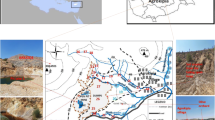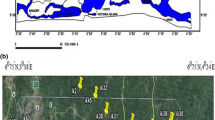Abstract
Water, sediment, and mine spoil samples were collected within the vicinity of the Okpara coal mine in Enugu, Southeastern Nigeria, and analyzed for trace elements using ICP-MS to assess the level of environmental contamination by these elements. The results obtained show that the mine spoils and sediments are relatively enriched in Fe, with mean values of 1,307.8(mg/kg) for mine spoils and 94.15% for sediments. As, Cd, Cr, Mn,Ni, Pb, and Zn in the sediments were found to be enriched relative to the mean values obtained from the study area, showing contamination by these elements. The mean values of Fe, Mn, Cu, and Cr in the mine spoils and mean values of Fe, Cu, Pb, Zn, Ni, Cr, and Mn in sediments, respectively, are above the background values obtained from coal and shale in the study area, indicating enrichment with these elements. The water and sediments are moderately acidic, with mean pH values of 4.22 ± 1.06 and 4.66 ± 1.35, respectively. With the exception of Fe, Mn, and Ni, all other elements are within the Nigerian water quality standard and WHO limits for drinking water and other domestic purposes. The strong to moderate positive correlation between Fe and Cu (r = 0.72), Fe and Zn (r = 0.88), and Fe and As (r = 0.60) at p < 0.05 as obtained for the sediments depict the scavenging effect of Fe on these mobile elements. As also shows a strong positive correlation with Mn (r = ≥ 0.70, p < 0.05), indicating that Mn plays a major role in scavenging elements that are not co-precipitated with Fe. In water, the strong positive correlation observed between Cr and Cd (r = 1.00), Cu and Ni (r = 0.94), Pb and Cu (r = 0.87) and Zn and Cu (r = 0.99); Ni and Pb (r = 0.83) and Zn and Ni (r = 0.97); and between Pb and Zn (0.84) at p < 0.05 may indicate similar element–water reaction control on the system due to similarities in chemical properties as well as a common source. Elevated levels of heavy metals in sediments relative to surface water probably imply that sorption and co-precipitation on Al and Fe oxides are more effective in the mobilization and attenuation of heavy metals in the mine area than acid-induced dissolution. The level of concentration of trace elements for the mine spoils will serve as baseline data for future reference in the study area.
Abstract
عينات مياه ورسوبيات وشوائب المنجم التي تم جمعها من ساحة منجم فحم أوكبارا الذي يقع في إنجيو جنوب شرق نيجيريا و وبعد تحليلها للعناصر الشحيحة باستخدام ICP-MS تم استخدمها لتقييم مستوى التلوث البيئي بهذه العناصر . أثبتت النتائج أن المناجم ملوثة وأن الرسوبيات أصبحت أغنى بالحديد ومتوسط تلوث المنجم هو 1307.8ملليجرام/ كيلو وتلوث الرسوبيات هو 94.15%. حيث وجدت عناصر المنجنيز و النيكل وكروم و زنك والرصاص مترسبة بنسبه أعلى من القيم المتوسطة التي تم الحصول عليها من منطقة الدراسة . القيم المتوسطة من الحديد والكروم والنحاس والمنجنيز من المنجم والقيم المتوسطة من الحديد والنحاس والرصاص و الزنك و النيكل و الكروم و المنجنيز في الرسوبيات كانت أعلى من القيم السابقة التي تم الحصول عليها من الفحم و الطمي الصخري في منطقة الدراسة والتي تبين زيادة في هذه العناصر . الماء والرسوبيات قليلة الحموضة ومتوسط القيم هي 4.22 ± 1.06 و4.66 ± 1.35 على الترتيب . جميع العناصر تقع في النطاق القياسي للمياه النيجيرية و حدود مياه الشرب ومياه الأغراض المحلية الأخرى الخاصة ب WHO إلا النيكل و المنجنيز و الحديد .علاقة الارتباط الايجابية القوية إلى المتوسطة بين الحديد و النحاس (r=0.72) و الحديد والزنك (r = 0.88) و الحديد والزرنيخ (r = 0.60) عند P < 0.05 في الرسوبيات تبين التأثير الكاسح للحديد على هذه العناصر . كما يتضح أيضا الارتباط الايجابي مع المنجنيز(r = >0.70, P < 0.05) الذي يبين أن المجنيز يلعب دوراً رئيسيا في العناصر المكتسحة التي لم تشارك الحديد. علاقة الارتباط الايجابية القوية المشاهدة في المياه بين الكروم و الكادميوم (r = 1.000) و النحاس و النيكل (r = O.94) و الرصاص والنحاس (r = 0.87) و الزنك والنحاس (r = 0.99) و النيكل و الرصاص (r = 0.83) و الزنك و (r = 0.97) و بين Ph و الزنك (0.84) عند P < 0.05 قد تبين تفاعل مماثل لمحتوى عناصر لها نفس الخصائص الكيميائية وأيضا نفس المصدر .مستويات مرتفعة من المعادن الثقيلة في الرسوبيات بالنسبة للمياه السطحية قد يعني ان الامتصاص وهطول الأمطار على الومنيوم وأكسيد الحديد لها تأثير أكبر ، في الجريان والتوهين على المعادن الثقيلة في منطقة المنجم ، من المحلول الحمضي المستحث . مستوى التركيز للعناصر الشحيحة في المناجم الملوثة تستخدم كبيانات مرجعية لموقع الدراسة .


Similar content being viewed by others
References
Adaikpoh EO, Nwajei GE, Ogala JE (2005) Heavy metals concentration in coal and sediments from River Ekulu in Enugu, coal city of Nigeria. J Appl Sci Environ Manag 9:5–8
Aggett PJ, Cornerford JG (1995) Zinc and human health. Nutr Rev 53:516–522
Akande S, Hoffknecht A, Erdtmann BD (1992) Rank and petrographic composition of selected Upper Cretaceous and Tertiary coals of Southern Nigeria. Int J Coal Geol 20:209–223
Awoniyi JF (1977) Nigerian mineral industry: its history, trend and prospect. J Min Geol 14:73–78
Chon H-T, Ahn JS, Kim J-Y, Je H-K (1999) Geochemical investigation of the environmental impact of an abandoned Au–Ag mine in Korea. In: Stanley CJ et al (eds) Mineral deposits: processes to processing. Balkema Rotterdam, UK, pp 1171–1174
Ezeigbo HI, Ezeanyim BN (1993) Environmental pollution from coal mining activities in the Enugu Area, Anambra State Nigeria. Mine Water Environ 12:53–62
Fuge R, Paveley CF, Holdham MT (1989) Heavy metal contamination in the Tanat Valley, North Wales. Environ Geochem Health 11:53–59
Goyer RA (1996) Toxic effects of metals. In: Klaasen CD (ed) Casarcett and Doull’s toxicology. The basic science of poisons. McGraw-Hill Health Profession Division. ISBN 0071054766
Jung MC, Thornton I (1996) Heavy metal contamination of soils and plants in the vicinity of a lead–zinc mine, Korea. Appl Geochem 11:53–59
Jung MC, Thornton I (1997) Environmental contamination and seasonal variation of metals in soils, plants and waters in paddy fields around a Pb–Zn mine in Korea. Sci Total Environ 198:105–121
Jung MC, Thornton I, Chon HT (2002) Arsenic, Si and Bi contamination of soils, plants, waters and sediment in the vicinity of the Dalsung Cu–W mine in Korea. Sci Total Environ 295:81–89
Krauskopf KB, Bird DK (1995) Introduction to geochemistry. McGraw-Hill, New York
Lee GL, Chon HT, Jung MC (2001) Heavy metal contamination in the vicinity of the Daduk Au–Ag–Pb–Zn mine in Korea. Appl Geochem 10:1377–1386
Loukola-Ruskeeniemi K, Kantola M, Halonen T, Seppanen K, Henttonen P, Kallio E, Kurki P, Savolainen H (2003) Mercury black shales and human Hg-intake in eastern Finland: impact and mechanisms. Environ Geol 43:283–297
Merrington G, Alloway BJ (1994) The transfer and fate of Cd, Cu, Pb, and Zn from two intrusive metal ferrous mine site in the U.K. Appl Geochem 9:677–687
Ministry of Mines and Steel Development (MMSD) (2008) Coal exploration and power generating opportunities in Nigeria. Nigerian Geological Survey Agency (NGSA)
Nigerian Standard for Drinking Water Quality (2007) NIS 554
Offodile ME (2002) Groundwater study and development in Nigeria. Jos Macon Geology and Engineering Services, Nigeria
Okagbue CO, Onuoha VO (1980) Environmental problems related to coal mining in Enugu area. Proceedings of Nigeria water and sanitation. Symposium on Groundwater Resources in Nigeria, Ikeja, Nigeria, pp 23–248
Onwuka OS, Uma KO, Ezeigbo HI (2004) Portability of shallow groundwater in Enugu Town, Southeastern, Nigeria. Glob J Environ Sci 3(1):33–69
Rose AW, Cravotta CA (1998) Geochemistry of coal mine drainage. In: Ridge T, Seil JM (eds) Coal mine drainage prediction, and pollution prevention in Pennsylvania., pp 1–22
Routh J, Ikramuddin M (1996) Trace-element geochemistry of Onion Creek near Van Stone lead–zinc mine (Washington, U.S.A): chemical analysis and geochemical modeling. Chem Geol 133:221–224
Sauve S, Hendershot W, Allen HE (2000) Solid-solution partitioning of metal in contaminated soils: dependence on pH, total metal burden, and organic matter. Environ Sci Technol 7:1125–1131
Siegel FR (2002) Environmental geochemistry of potentially toxic metals. Springer, Berlin
Thornton I, Plant J (1980) Regional geochemical mapping and health in the UK. J Geol Soc (Lond) 137:575–586
USPHS (1997) Toxicological profile for Zn on CD-ROM agency for toxic substances and disease registry. US Public Science
WHO (2004) Guidelines for drinking water quality. WHO, Geneva
Zielinski RA, Otton JK, Johnson AC (2001) Sources of salinity near a coal mine spoil pile, North Central Colorado. J Environ Qual 30:1237–1248
Author information
Authors and Affiliations
Corresponding author
Rights and permissions
About this article
Cite this article
Nganje, T.N., Adamu, C.I., Ugbaja, A.N. et al. Environmental contamination of trace elements in the vicinity of Okpara coal mine, Enugu, Southeastern Nigeria. Arab J Geosci 4, 199–205 (2011). https://doi.org/10.1007/s12517-010-0173-7
Received:
Accepted:
Published:
Issue Date:
DOI: https://doi.org/10.1007/s12517-010-0173-7




